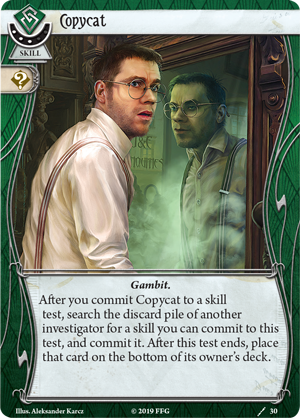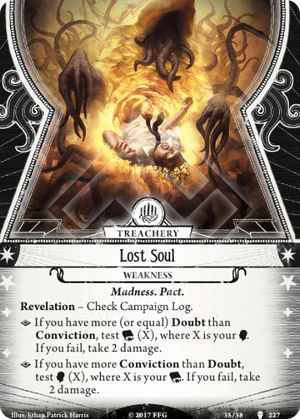
Rules Question: Does picking 'investigate' turn off only the basic action, or also investigate actions on encounter cards and assets?
Similarly, does picking 'move' turn off shortcut, pathfinder, etc.?

Rules Question: Does picking 'investigate' turn off only the basic action, or also investigate actions on encounter cards and assets?
Similarly, does picking 'move' turn off shortcut, pathfinder, etc.?

Hello.
I'll be adding this to my Zoey deck with two Well Maintained arkhamdb.com Combined with Stick to The Plan with one (or maybe two) Act of Desperation arkhamdb.com and Contraband I am hoping her BAR will keep bouncing....

Anybody else have trouble with ArkhamDB decks adding this after the intro to The Witching hour instructs you to add both it and The Tower XVI to your deck? After the scenario, I tried to add it as a campaign card, but it wasn't there - it was just under the regular assets, and when I added it there, it tried to charge me XP. Did I miss something?

This card has interesting applications in supporting a teammate, as you are not limited to committing it to your own tests. An investigator’s deck typically has more skills suited to their own specialty than someone else’s. This means you can help out your guardian pal with their own Vicious Blow, recommit a seeker’s Deduction to their next investigation or even fill out a fellow rogue’s poker hand if one of their Aces ended up in the discard.

Note: There is some disagreement (see comments below)
This is not a review, instead it is for those lost souls who choose to play with Calvin Wright
I couldn't find out how this card interacts with Calvin Wright with a google search so here is my interpretation (this also applies to other investigators)
Using the top part of this card in the example, the skill test timing is broken down to steps. ST.1 is that we determine that this is a [Intellect] skill test ST.5 is when modifiers are added to the investigators base skill value for the test type ([Intellect] in this case), if Calvin has 4 horror on him, then with his ability he will add +4 to a total modifier value of 4. ST.6 is when failure/success is determined. The difficulty of the test is Calvin's [Willpower]. As this is an [Intellect] test, at no point where we instructed to modify Calvin's [Willpower] value, so therefore the test difficulty is 0. As 4>0, Calvin is successful in this test.
This applies to other investigators too. Using Daisy Walker with St. Hubert's Key, Daisy would be testing 6 [Intellect] against 3 [Willpower]. Because the skill test is an [Intellect] test, we add the +1 modifier from St. Hubert's Key, but do not add the +1 Willpower modifier from St. Hubert's Key.
This is not an official interpretation as one doesn't exist yet, I hope this helps!
KakuRainbow